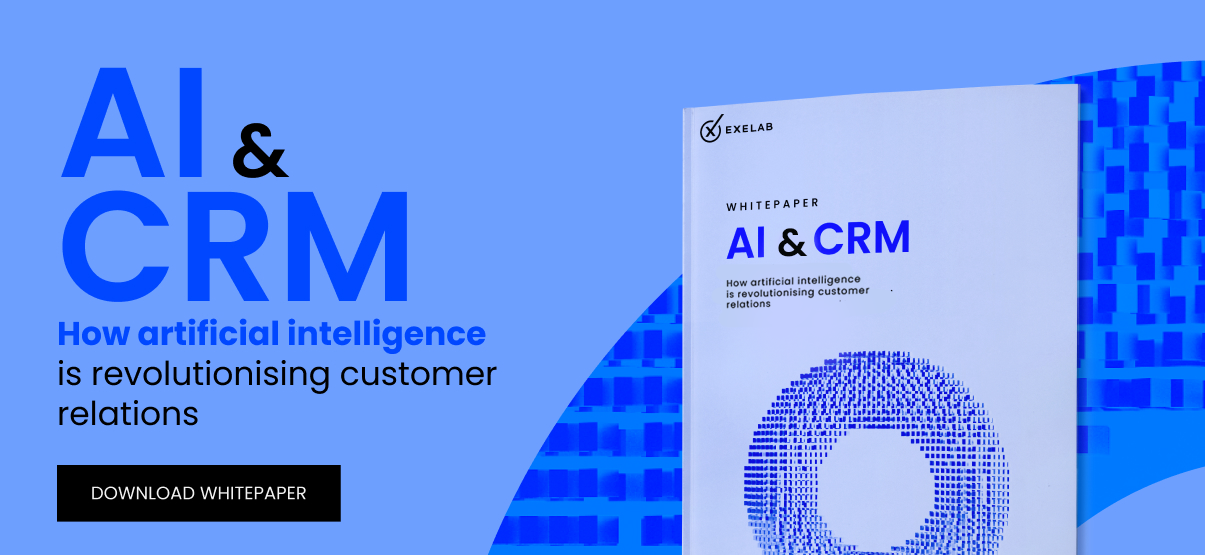
The Future of Loyalty in the Data Era
Increasingly sophisticated and personalized customer experiences...
Read moreInsights
Go to the BlogIn primo piano

The Future of Loyalty in the Data Era
Increasingly sophisticated and personalized customer experiences...
Read moreEnterprise Solutions
Recent Publications
Whitepaper

How artificial intelligence is revolutionising customer relations
Download the WhitepaperExtra
A new horizon for CRM
Automation and integration: apps

100% digital, fast and paper free processes
A new standard based on AI and HubSpot
Integrated and optimized e-commerce management with HubSpot
Exelab World
Where ideas and innovation meet
Texts to meet tomorrow's challenges
Discover our insights: visit the blog
Insights
Go to the BlogIn primo piano

The Future of Loyalty in the Data Era
Increasingly sophisticated and personalized customer experiences...
Read moreAbout Us
Innovation, excellence, technology: at Exelab we design the future of business processes
Exelab and The Client Group: an operational synergy to raise customer experience to the highest level
Careers
We are always looking for talent ready to make their mark: explore our opportunities
We're hiring!Exelab is an official partner of


Events
Discover our EventsMost Recent Event

Solutions
Enterprise Technology
HubSpot
Discover
About
Solutions

Exelab Solutions
Insights
Go to the BlogIn primo piano

The Future of Loyalty in the Data Era
Increasingly sophisticated and personalized customer experiences...
Read moreEnterprise Technology

Enterprise Solutions
Recent Publications
Whitepaper

How artificial intelligence is revolutionising customer relations
Download the WhitepaperHubSpot

Extra
A new horizon for CRM
Automation and integration: apps
Discover


100% digital, fast and paper free processes
A new standard based on AI and HubSpot
Integrated and optimized e-commerce management with HubSpot
Exelab World
Where ideas and innovation meet
Texts to meet tomorrow's challenges
Discover our insights: visit the blog
Insights
Go to the BlogIn primo piano

The Future of Loyalty in the Data Era
Increasingly sophisticated and personalized customer experiences...
Read moreAbout

About Us
Innovation, excellence, technology: at Exelab we design the future of business processes
Exelab and The Client Group: an operational synergy to raise customer experience to the highest level
Careers
We are always looking for talent ready to make their mark: explore our opportunities
We're hiring!Exelab is an official partner of


Events
Discover our EventsMost Recent Event

Business Automation (BA) or Business Process Automation (BPA) encompasses all business processes (of varying complexities) composed of repeated and repeatable actions that are automated through the interface and collaboration of multiple software programs.
One of the fundamental software that contributes to the automation of many business processes is CRM.
The concept of business automation is often associated with the words productivity, time, and error reduction.
In the studies mentioned below, the correlation between a company's expansion, the well-being of its employees, and its level of automation is examined. The reasons leading to integration, the benefits on productivity, and the failures that have partially negated the efforts taken are also observed.

From Gartner
Multiple software presence in a company's tech stack is often inevitable and, as highlighted by Hubspot, leads to inevitable initial consequences:
The flexibility of software is its ability to customize, adapt, and cooperate with other systems and in various contexts. A business automation tool that performs well in different business models or changing conditions is therefore highly valuable and potentially scalable.

Index for progressive adoption of Technology and Automation
A study conducted by McKinsey & Company in 2020 on companies with a turnover exceeding one billion dollars that successfully implemented business automation analyzed the reasons behind seeking such integration. The majority of decision-makers considered business automation a priority in their growth strategy. The second most influential driver was the uncertainty about the effectiveness and efficiency of pre-integration processes.

Companies satisfied with the integration particularly appreciated improved communication and coordination between units and business processes. Other positive outcomes included:
Companies unsuccessful post-integration continued searching for a solution that could lead to long-term savings and address efficiency issues in their processes. Nevertheless, post-integration, improved clarity in managerial communications was noted.
Between 2020 and 2022, a Gallup survey on workers from various sectors noted a decline in US employee engagement with their companies, witnessing a drop from 36% to 32%. Enthusiasm and workplace involvement specifically decreased concerning:
Reducing human intervention allows individuals more time to think about leveraging their skills.
According to McKinsey, 31% of companies have automated at least one function, and 60% of roles include about 30% of automatable activities. For a company's sales department, for example, this involves:
These are operations performed using various tools, and when done manually, they significantly impact time and error risk. In business automation software, communication is clear, reducing clicks and ensuring a smooth process flow.
Based on this article, is it always sensible to seek process automation?
Indeed, in a large company, expansion, growth, and harnessing human potential should always come first; a business automation project can make all this possible.
